THU 06.04. & FRI 07.04.
Preview Opening
of "The Laboratory"
of "The Laboratory"
SAT 08.04.
Public Opening
of "The Laboratory"
of "The Laboratory"
FRI 12.05. 6PM at The Laboratory
Love, Peace and Resources
Workshop by Erik van Buuren
Workshop by Erik van Buuren
FRI 16.06. 5PM
"Elusive Earths"
by Jennifer Teets and Lorenzo Cirrincione
by Jennifer Teets and Lorenzo Cirrincione
SAT 17.06. 5-6PM
Fernando García-Dory
at Otobong Nkanga's Carved to Flow
at Otobong Nkanga's Carved to Flow
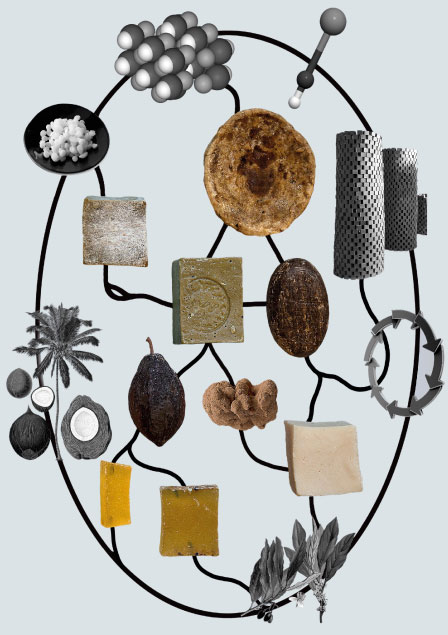



The word “support” has many meanings. “To support” can be to hold up, carry, brace, reinforce or underpin. It can also be to provide for someone or something – to take care of and look after. Furthermore, it can be to give moral support, to be a source of strength and comfort, to encourage, buoy up, hearten and soothe. In speech and thought, it can be to substantiate, to attest, verify and authenticate.
As a thing of physical limits, a support can be a pillar or a beam, which through compression transmits the weight of the above to other structural elements below; it can be the place where the overlooking and the looking up meet. Whether small and wooden like a beam, or glassy metal like a post, or duteous marble like a caryatid, the purpose of a structural support is to be strong and unwavering; except of course for when the underpinning’s hidden, then beams and pillars can also be decorative – unconcerned with muscle but robust-looking to the eyes. As pillars compress to transmit weight, or sit still to look as if they are, they are not unlike tissues of plants that are joined together by aspiring horticulturalists to bolster up shared growth. The scion (the upper part of the combined plant) and the rootstock (the lower part) which keep the appearance of separate parts, come together to merge into one another – to permanently intertwine in this new life that is being grafted at the point where the overlooking and the looking up meet, like carrying on the head – human-powered transport – where burdens balance above sight but weigh heavily on the nervous system.
Supports -the actions, the objects, the metaphors- they move in circles, concentrically expanding and coiling into and onto each other. One support supports another, one grafts into another, one is grafted from another and into another yet, inspiring ontologies of curves and arches – economies in which material flows out and back. Biological nutrients circulate and re-enter the biosphere. Technical nutrients circulate and re-enter the production system. They regenerate and restore, again and again, forming circular economies. And then, there’s that which unnamed, they generate silently for future generations to anatomize and look at.
Carved to Flow is one such circle arching out and back from Athens to Kassel to somewhere else. In Athens it is a laboratory where oils, butters and lye from all around the Mediterranean, Middle East, North and West Africa meet to create a soap. In Kassel it is storage and distribution, breathing stacked in towering blocks of saponaceous lattice, danced around through carrier hands to generate that which will circle back to somewhere else, to take new form – a no-waste product carved to flow.
MAYA TOUNTA


Of a circular economy is a specific salt of a fatty acid – “o 8” – a soap made of water, charcoal and lye, and other butters and oils from across the Mediterranean, Middle East, North and West Africa.

It is facilitator of barbequing Sundays, non-aspirational holidaying, and familial clichés. To do with charcoal (render), or to do over charcoal (cook), or even yet to undo with charcoal (treat drug overdose) – it wields both language and will. It remembers fire and industry, geographically omnipresent. Its discovery could have occurred many times over – “of independent invention” many would say. Now, non-autonomously, it gets moulded into briquets, bars, powder strips or names for a colour.
The runny light into soap is water. The binding and untethering substance that presents every other ingredient with mass, with which to act and be subject. Water: the resource treated by the economy as object to sovereign producers overlooking its cyclical nature and wellspring of circular economics. Rainfall shocks – land use – agricultural yields. Rainful shocks – impacts on human capital, on firm performance. Water scarcity – freshwater resilience. Water, of the womb. Water at the bar; at the restaurant. Water in our bodies; in the bodies of lovers; in the bodies of enemies; in the bodies of enemies of state and of state-heads. We think of “precious”, “inestimable” – of holly wells. “Make it rain” (money) we say. It’s pouring outside. o 8 is pouring.
The soap’s irrigation system broadcasts thoughts and fantasies buried under oil and butter amalgamations. 4 oils, 3 butters – they once formed the middle. Now they are diffused – sent out – felt throughout the bar. There’s encouragement to speak, say their names outloud – acknowledge in slow time what is being brought back into the skin and into the larger irrigation system of porcelain, plastic, metal, earth and salt. “Olive oil” – “Coconut Oil” – “Laurel Oil” – “Sage Oil” – “Shea Butter” – “Cocoa Butter” – “Babassu Butter”. There is no beginning, middle, or end. They were once pure. Now they’re social- ised. From what they remember of themselves, and of where they came from, they form a sense of self, or inter-self – of becoming in relation. You hear it in the hushed babble of o 8 repositories: the false silence of the bathroom, the storage unit, the pilestock in display, the cloaking paper or the hexagon mould that temporarily hosts them. “We are oils and butters.” “We are fundaments.”
MAYA TOUNTA




The Laboratory on Archimidous 15 in Athens was a site-specific installation that during documenta 14 functioned as a soapmaking laboratory. Housed in the ground floor of a residential building in Kallithea, in the area that connects the city-centre with the port, the laboratory temporarily contributed to the architectural landscape of the area – an asphalt street network bestrewn with warehouses and social housing. Equipped with custom-made furniture and appliances for soapmaking; with a reading room, a wall-drawing, and an intricate web of clay channels funnelling oil; the laboratory presented itself simultaneously as one work, as an exhibition, and as a social space. There, Nkanga, together with soapmaker Evi Lachana hosted regular soapmaking sessions during which the public was invited to participate in the process of making hexagonal soaps that Nkanga then added to the installation. Using only natural ingredients traditionally associated with cold process soapmaking – olive oil, laurel oil, sage oil, coconut oil, shea butter, babassu butter, cocoa butter, charcoal, camwood, indigo, various seeds, and essential oils – Nkanga explored the narrative potential of the cold-process soap as a medium capable of expressing complex geographical, historical and affective entanglements. In addition to the workshops, in the laboratory, curator Maya Tounta hosted a public programme of events, which brought together the voices of different artists, researchers, and businesses in an exploration of the ritual fringes of various work processes. Addressing diverse practices ranging from ingesting clay tablets (Elusive Earths, Jennifer Teets & Lorenzo Cirrincione) to collecting waters (Of Accords, Iris Touliatou), the programme looked at how artists can inform the narratives that surround everyday products by appropriating and repurposing their material vocabularies. The Laboratory on Archimidous 15 closed on July 16, 2017 following the end of documenta 14 in Athens. In the work’s third phase, the Germination, the laboratory is re-installed within exhibitions that showcase the work.
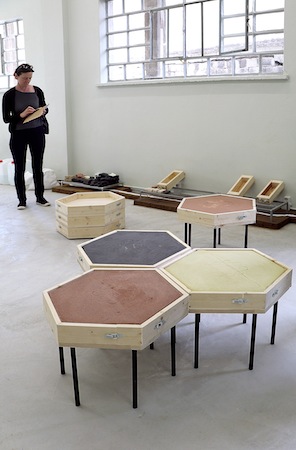
The Laboratory
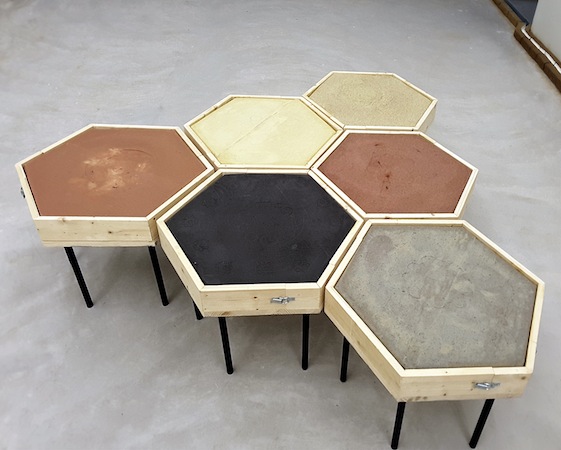
The Moulds
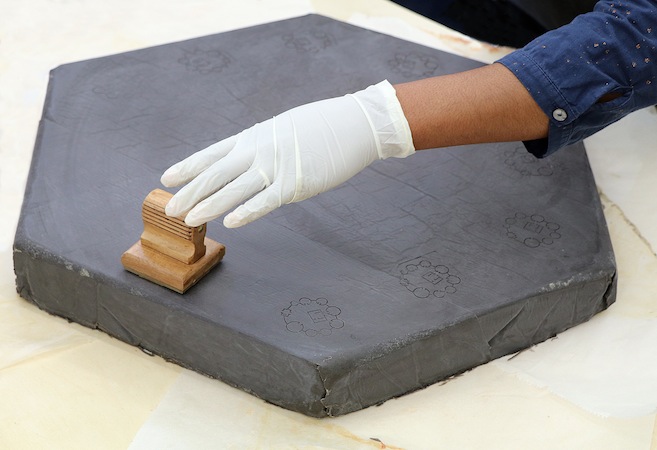
The Stamp
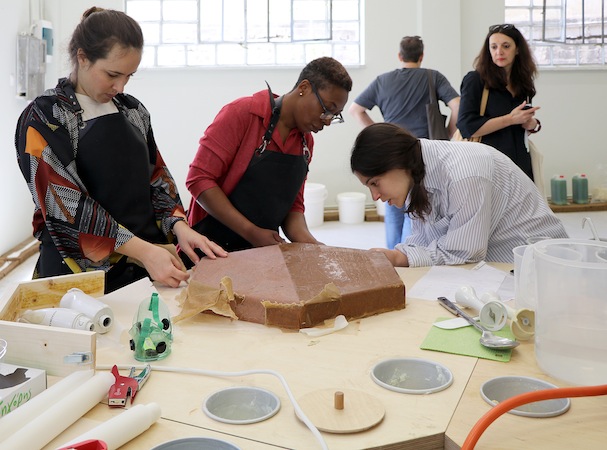
The Workstation
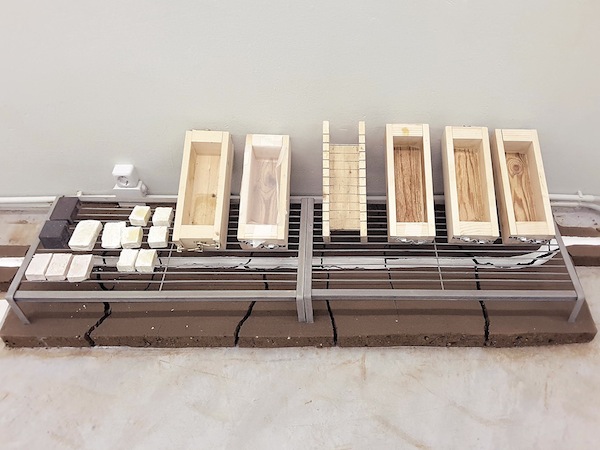
Carved To Flow
OPENING HOURS
April 10-July 16
Monday – Friday 11:00-18:00
or by appointment
April 10-July 16
Monday – Friday 11:00-18:00
or by appointment
CONTACT
Maya Tounta
Maya Tounta


Otobong Nkanga |
Laouta Shop |
VisOlivae Kalamata
Maya Tounta |
this is that |
Saygel & Schreiber
Orestis Argiropoulos |
Michelangelo Corsaro
ASSISTANCE
Panos Profitis |
Ida West-Hansen |
Gerasimos Avlamis
Panagiotis Zachoulitis |
Konstantinos Christodoulidis
Laouta Shop |
VisOlivae Kalamata
Maya Tounta |
this is that |
Saygel & Schreiber
Orestis Argiropoulos |
Michelangelo Corsaro
Ida West-Hansen |
Gerasimos Avlamis
Panagiotis Zachoulitis |
Konstantinos Christodoulidis
Otobong Nkanga was born in 1974 in Kano, Nigeria, and has lived in Antwerp for nine years. She recently had solo exhibitions at Nottingham Contemporary (2016), In Situ Gallery in Paris (2016), Berkeley Art Museum and Pacific Film Archive (2016), M HKA in Antwerp (2015), Somerset House in London (2015), Portikus in Frankfurt (2015), Kadist Art Foundation in Paris (2015) and the Performance Room at Tate Modern in London (2015). In 2016, she also had major international projects in Shanghai and Beirut (Landversation). She has taken part in several international group exhibitions, including the 13th Biennale de Lyon (2015), the 31st São Paulo Biennial (2014), the 8th Berlin Biennale (2014) and the Sharjah Biennial 11 (2013). She won the Yanghyun Prize in 2015. In 2013 – 2014, she was a guest of the DAAD Berliner Künstlerprogramm – Artists-in-Berlin Program.
www.otobongnkanga.com
www.otobongnkanga.com
Natural soaps, handmade in the old world tradition with pure essential oils, wild and organic herbs, and extra virgin olive oil, and herbal cosmetics prepared with oil, wild herb extracts, essential oils and aromatotherapy herbal essences.
www.laoutashop.com
www.laoutashop.com



A shop founded on the body. A bartering orbit surrounding flesh and bone. Produce that pulls on the shoulder, pulls on the heart, rests on the thigh and the extended arm, and fluctuates imperceptibly with each contraction of the lungs and the stomach. An architecture erected on breaths, perspiration and the other exhaustible and belligerent states of a human mass. In any other shop, one might find the seller’s body moving straight- forwardly across the regimented aisles. Here, the body, together with the produce, the cash register, the decoration and the lights,

has been hybridised. Strapped onto it now there extends a wooden and steel frame, on which the various visible pockets contain bartering actions: the lathering of the soap, the packaging, the collecting of the money, the plant that tells of material. Each pulls. Each is a weight and a counterweight, in an economy where lunch and small intestine, where mood and careful thought, have their stake. Grazing the wood softly can be seen a telling cloth, of convertible fashion, on which colours and letters tell stories of recipes being forged, half-visibly trading in narratives.
The stock is ‘a type of security that signifies ownership in a corporation’, or merely another way of saying ‘merchandise’ or ‘goods for sale’. Yet here, stock is more like bean- stalk, the fast- growing and proverbially tall stem of a plant, on which adventure is woven. Soaps of equal appearance but variable expression, reflecting in manner a dark marble with milky highlights, form a lattice, going up. On it, the soaps as bricks, are each in balance with the stock; others on top, others at the bottom, others in some strange middle ground, waiting their turn. Here are the goods stored, beautiful in their odourless silence, almost idiomatic yet in no relation to existing idioms – the O8 Black stone towers, where 7 oils and butters from across the Mediterranean, Middle East, North and West Africa, suffused with charcoal, water and lye, mark a point of sale, and a point of arrival. It is them– the throbbing support system, the carrier network.
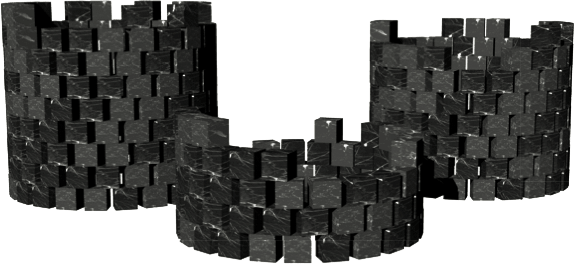
The Warehouse & Distribution phase centred on O8 Black Stone – a recipe for a cold process soap created by Nkanga, containing 7 different kinds of oil and butter from across the Mediterranean, Middle East, North and West Africa, and charcoal. In the months preceding the opening of documenta 14 in Kassel, Nkanga worked with Greek soapmakers Vis Olivae to produce 15000 O8 Black Stone soaps. In June, the soaps were sent to Kassel where Nkanga incorporated them into her three installations in the Neue Galerie, the Neue Neue Galerie (Neue Hauptpost), and the Glass Pavilions on Kurt-Schumacher-Strasse. Variously stacked into lattice-like columns and vertical blocks, the structures made reference to the Aleppo soap repositories. The installations also consisted of lightly planted words – poetic scents – placed on custom-made curtains and body-bound architecture intended to be worn by performers. The ‘distribution’ part of this phase was conceived as an ongoing public space peformance which would consist of presenting the soap to people in the street, talking about the work, and mediating its sale under specific conditions – giving performers certain liberties to refuse sale if, for example, they felt they were being treated disrespectfully by a prospective buyer, and for a limited time, allowing the sale of only one bar per person, to name a few. The sale was conceived as a commercial transaction and at the same time as a performative, participatory action geared toward the further development of the work. Nkanga intended to use the proceeds from the sales of the soap to set up a foundation in Nigeria which would support research into local material cultures, and through its activities extend the life of the work itself. Her intention which had been to create a self-sustaining artwork based on a direct transaction informed by specific narratives would be the basis for the work's third phase, the Germination.


For the third phase of the work titled the Germination, Nkanga has created The Carved to Flow Foundation that has its base in Akwa Ibom, Nigeria. The Foundation is conceived to be a platform dedicated to researching material cultures and fostering shared experimentation and exchange locally. Operating with the proceeds from the sales of the O8 Black Stone soaps, under Nkanga’s direction, the Foundation, which will take shape in the coming year, will realise the work’s founding ambition to achieve self-sustenance; it will become, in other words, the organism that will have grown from the seeds of the work’s previous two phases. In parallel to its activities in Nigeria, the Foundation will contribute to foreign initiatives spearheaded by people in its network. An instance of this kind of support will be its contribution to the maintainance of a space in Athens, Greece where soapmaker Evi Lachana will set up a cosmetic lab, and curator Maya Tounta a non-profit art space.


THURSDAY 06.04.
14:00-18:00
FRIDAY 07.04.
11:00-18:00
14:00-18:00
FRIDAY 07.04.
11:00-18:00
PREVIEW OPENING
OF “THE LABORATORY”
Preview Opening of “The Laboratory”, a place where oils, butters and lye are kept stock-still, funnelled throughout the space and brought together at the workstation to create soap. On Thursday and Friday, Otobong Nkanga and Evi Lachana will be making prototypes of soap recipes that will be left in the moulds that form the laboratory’s incubatory architecture, to mature over time.
OF “THE LABORATORY”
SATURDAY 08.04.
11:00 - 21:00
11:00 - 21:00
PUBLIC OPENING
OF “THE LABORATORY”
Public opening of “The Laboratory”, a place where oils, butters and lye are kept stock-still or funnelled through- out before they are brought together again to create soap. Otobong Nkanga and Evi Lachana, together with participants from the Melissa Network for migrant women in Greece, will be making a special recipe using olive oil, lemon and orange.OF “THE LABORATORY”
Melissa is a network for migrant women in Greece, promoting empowerment, communication and active citizenship.
FRIDAY 12.05. 6PM
AT THE LABORATORY
AT THE LABORATORY
LOVE, PEACE AND RESOURCES
WORKSHOP BY ERIK VAN BUUREN
This interactive workshop will explore the circular economy model and how we can apply the circularity approach in developing beneficial transformational systems for all, drawing on the wealth of research, design practice and throught leadership of this field. The circular economy is a bold idea that has the potential to transform our relationship with materials and our economic system. It describes how we can move from a linear model - where we "take, make and dispose" of materials - to design principles and business-societal models that are regenerative and environmentally and socially conscious.
WORKSHOP BY ERIK VAN BUUREN
Erik's workshop introduces a series of talks, workshops and other events that will take place at the Laboratory between May and June, exploring the observance of ritual work and the presence of ritual within production, and looking more widely at the transmission of knowledge around craft and production, networks of trade and the practical realities of making and selling.
The programme is curated by writer and curator Maya Tounta.
Erik van Buuren is inventor at and founder of Fundamental School and wishy-washy. Over 15 years, Erik’s work has been improving quality of life by promoting and developing beneficial and healthy places to live and work. By shaping and defining a positive role for business and organisations, sustainability has also become a drive for innovation. In addition to circular and detox product development, Erik also focuses on sustainable investment. In 2016 he participated in the Dilijan Arts Observatory in Armenia and is a lecturer at universities, whilst also curaings sustainable exhibitions. From 2012-2014 he was jury member of the German Design Prize. Erik (Dutch) is a material science and technology engineer (M.Sc.) and lives and creates in Berlin.
FRIDAY 16.06. 5PM
ELUSIVE EARTHS
BY JENNIFER TEETS AND LORENZO CIRRINCIONE
For the second event that takes place in Otobong Nkanga’s laboratory installation in Athens under the guise of a public programme exploring the mentality of ritual in resource consumption, we welcome Jennifer Teets and Lorenzo Cirrincione’s “Elusive Earths” – a joint research and evolving hybrid production surrounding the practice of clays with forgotten origins, largely centred on geophagy - the ingestion of edible soils, across the globe, and in an archaeological depth of time. Since 2014, the research has looked at terra sigillata, terra preta, and pan de tierra bendita, amongst other rare clays, spanning an expansive geography from the small island of Lemnos in Greece to Colombia to Oaxaca, Mexico. As a preamble to Elusive Earths IV, it returns to Athens, Greece by way of Lemnos, to take further inventory of ingestible clays and the imaginaries created around them; to look further at our vested belief in their truth, so as to ruminate on potent pharmacological convictions in effort to expose a point of vulnerability within an economy seeking to commodify the longing for a cure.BY JENNIFER TEETS AND LORENZO CIRRINCIONE
Lorenzo Cirrincione is a philosopher, curator, and artist living and working in Paris. Doctor in history of science, he is currently writing on early modern scientific collections – how they challenge us and stretch beyond obsolete ideas of artistic privilege and appropriation. As an artist his work investigates new ways of exhibiting and performing knowledge, mirroring the social and cultural games in the rich history of trade relations and cultural transfers. From 2004 to 2015, Lorenzo Cirrincione co-directed France Fiction, an artistic and curatorial entity that organized over eighty exhibitions in France and abroad.
Jennifer Teets is a contemporary art curator, writer, researcher and performer born in Houston, Texas, living and working from Paris. She is known for her research on cheese, mud, and terra-sigillata – their transitioning towards materiality and entity and their ability to become something else when put in an exhibition or an essay. She co-hosts with Margarida Mendes, The World in Which We Occur, an event series taking place over the telephone, loosely inspired by, and set in the legacy of hybrids that have emerged out of artist James Lee Byars’ 1969 performance World Question Centre. Teets holds a Master in Experimentation in Arts and Politics from Sciences Po, Paris (under the direction of Bruno Latour). From 2003-2007, she spearheaded the contemporary art program at the Sala de Arte Público Siqueiros in Mexico City, the former home/studio of Mexican Muralist David Alfaro Siqueiros. She has written extensively on art and curating in international art magazines and other publications.
FRIDAY 17.06. 5-6PM
Archimidous 15, 17778, Moschato, Athens
Archimidous 15, 17778, Moschato, Athens
Fernando García-Dory
at Otobong Nkanga's Carved to Flow
For the third event that takes place in Otobong Nkanga’s laboratory installation in Athens, under the guise of a public programme exploring the mentality of ritual in resource consumption, we welcome artist, sociologist and agroecologist Fernando García-Dory. García-Dory will speak about his work as a producer of “living culture”, using art production to precipitate social change and reconsider our relationship to the biosphere. García-Dory’s work investigates questions surrounding land use, food production and farming, and the forms of social organisation that frame them. This is aided through an enquiry into understandings of the culture-nature dialectic, social modeling and of possible futures. Through individual and collective projects, from drawings to agroecological cooperatives, expanded sculpture and more, Garcia-Dory looks at cheese production, shepherding, farming, and nomadism, among other practices and processes, in a way that bridges imagination and scientific knowledge to question forms of producing and living. Along with “Seeds in net” (2004), “A Shepherd’s School” (2004) and “A Dairy Museum” (2012), he will speak about “INLAND” (www.inland.org), an arts collective and a collaborative agency started in 2009, dedicated to agricultural, social and cultural production.
at Otobong Nkanga's Carved to Flow

 15 Archimidous str.
15 Archimidous str.